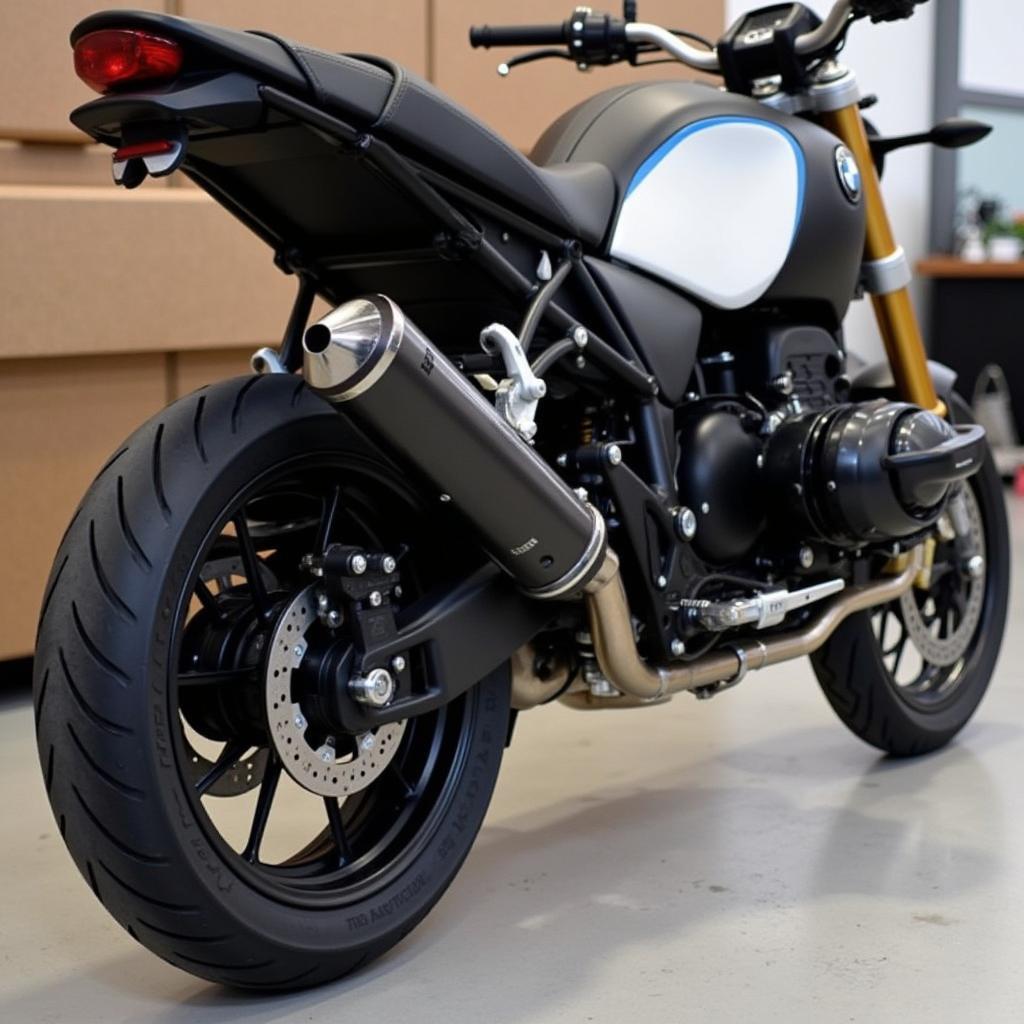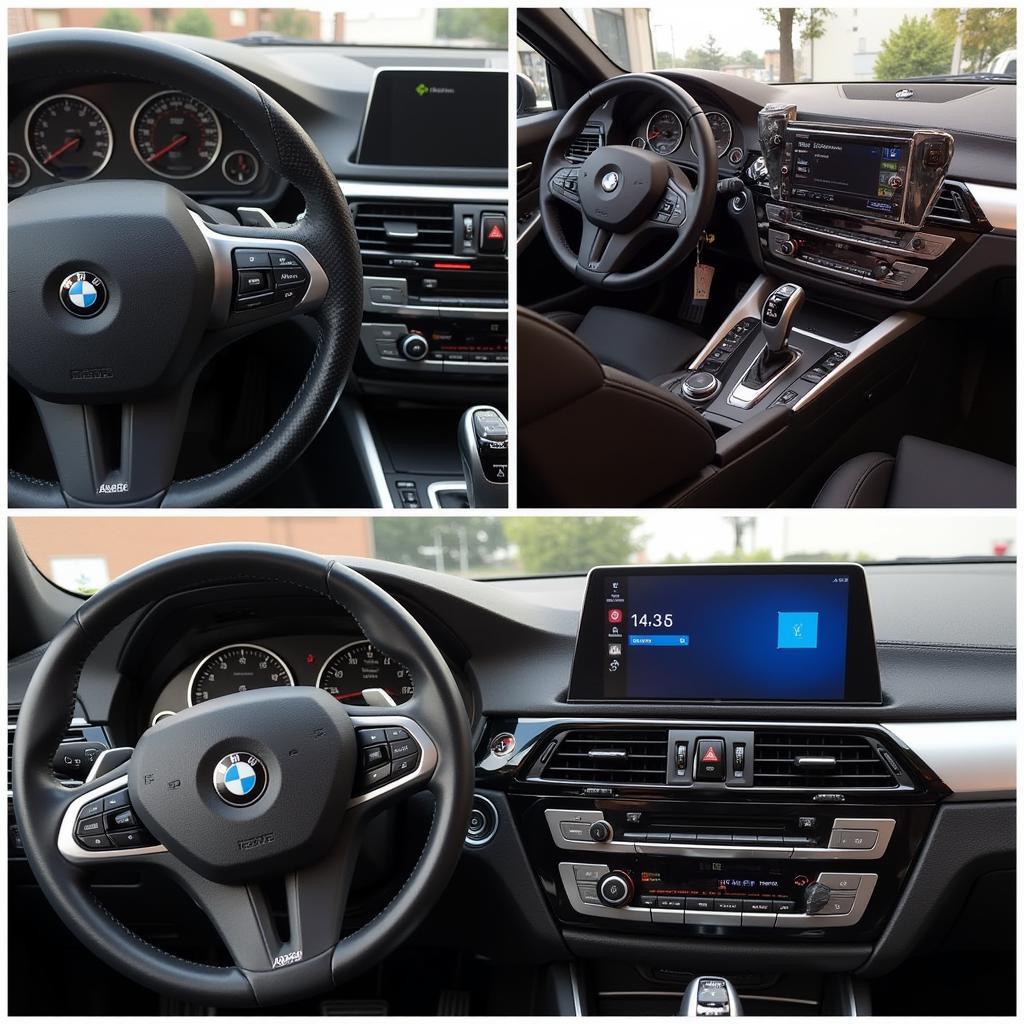The distinct rumble of a BMW R nineT Scrambler is more than just engine noise; it’s a statement. This article explores the nuances of the BMW R nineT Scrambler sound, from its origins to customization options, troubleshooting, and maintenance. We’ll delve into the technical aspects, discuss common issues, and offer expert advice on how to achieve the perfect Scrambler soundtrack.
Understanding the Stock BMW R nineT Scrambler Sound
The stock exhaust system of the BMW R nineT Scrambler is designed to produce a deep, throaty sound that’s both powerful and refined. This signature sound is a result of the bike’s air-cooled, boxer twin engine, combined with a carefully engineered exhaust system. The exhaust note is characterized by a low-frequency rumble at idle, which builds into a satisfying roar as the revs climb. This sound is not just about volume; it’s about the character and texture of the sound waves, a carefully crafted symphony of combustion.
 BMW R nineT Scrambler with Stock Exhaust
BMW R nineT Scrambler with Stock Exhaust
Customizing Your BMW R nineT Scrambler Sound
Many riders choose to personalize their Scrambler’s sound by installing aftermarket exhaust systems. This is a popular modification that can dramatically alter the bike’s acoustic profile. Aftermarket exhausts offer various benefits, from enhanced performance to weight reduction and, of course, a customized sound. Options range from slip-on mufflers for a subtle change to full systems that completely overhaul the exhaust setup.
Choosing the Right Aftermarket Exhaust
Selecting the right aftermarket exhaust involves balancing several factors. Do you prioritize a louder, more aggressive sound, or a refined, deeper tone? Are you looking for performance gains, or is weight reduction your primary concern? Researching different brands and models, considering materials like stainless steel or titanium, and understanding the impact on backpressure are all crucial steps.
Installation and Tuning
Proper installation and tuning are essential for maximizing the benefits of an aftermarket exhaust. Incorrect installation can lead to performance issues, leaks, and even damage to the engine. Tuning the bike’s fuel injection system is often necessary to ensure optimal performance and prevent running lean, which can cause engine damage.
Troubleshooting BMW R nineT Scrambler Sound Issues
Occasionally, R nineT Scrambler owners encounter sound-related problems. These can range from annoying rattles and vibrations to more serious issues like exhaust leaks.
Common Sound Problems and Solutions
A common issue is a rattling sound coming from the exhaust system. This is often caused by loose heat shields or internal components. Tightening loose bolts or replacing damaged parts usually solves the problem. Exhaust leaks can also occur, often at the joints between pipes or at the muffler connection. These leaks can create a hissing or popping sound and should be addressed promptly to prevent further damage and ensure optimal performance.
Maintaining Your BMW R nineT Scrambler Exhaust System
Regular maintenance is essential for preserving the sound and performance of your Scrambler’s exhaust system. Keeping the exhaust clean and free of debris can prevent corrosion and ensure proper airflow. Regular inspections for leaks and damage are also crucial.
Conclusion
The BMW R nineT Scrambler sound is a defining characteristic of this iconic motorcycle. Whether you prefer the stock sound or crave a customized roar, understanding the intricacies of the exhaust system is key to maximizing your riding experience. From choosing the right aftermarket exhaust to troubleshooting common issues, this guide provides the information you need to achieve the perfect Scrambler soundtrack. Proper maintenance will ensure your R nineT Scrambler continues to deliver its signature sound for years to come.
FAQ
- What is the average cost of an aftermarket exhaust for the BMW R nineT Scrambler? Aftermarket exhaust systems can range from a few hundred dollars for a slip-on muffler to over a thousand dollars for a full system.
- Do I need to re-tune my bike after installing an aftermarket exhaust? In most cases, yes. A re-tune is often necessary to optimize performance and prevent damage after installing an aftermarket exhaust.
- How often should I inspect my exhaust system? It’s recommended to inspect your exhaust system for leaks and damage every few hundred miles or during regular maintenance checks.
- Can I install an aftermarket exhaust myself? While it’s possible, professional installation is recommended to ensure proper fitment and avoid potential problems.
- What are the legal requirements for motorcycle exhaust noise levels? Noise regulations vary depending on your location. Check your local laws to ensure your exhaust system complies with the regulations in your area.
- What are some reputable brands of aftermarket exhausts for the BMW R nineT Scrambler? Some popular brands include Akrapovič, Remus, and Vance & Hines.
- How can I reduce the popping sound on deceleration with an aftermarket exhaust? A popping sound on deceleration can often be addressed by adjusting the fuel mixture through a re-tune.
Common Scenarios and Questions:
Scenario: My Scrambler’s exhaust sounds much louder than usual.
Possible Causes: Exhaust leak, damaged muffler, loose components.
Scenario: I hear a rattling sound from my exhaust.
Possible Causes: Loose heat shield, internal component damage.
Scenario: My bike is performing poorly after installing an aftermarket exhaust.
Possible Causes: Incorrect installation, need for a re-tune.
Related Topics:
- BMW R nineT Scrambler performance upgrades
- Motorcycle exhaust system maintenance
- Choosing the right motorcycle exhaust
When you need assistance, contact us via Whatsapp: +1 (641) 206-8880, Email: CARDIAGTECH[email protected] or visit us at 276 Reock St, City of Orange, NJ 07050, United States. We have a 24/7 customer support team.

